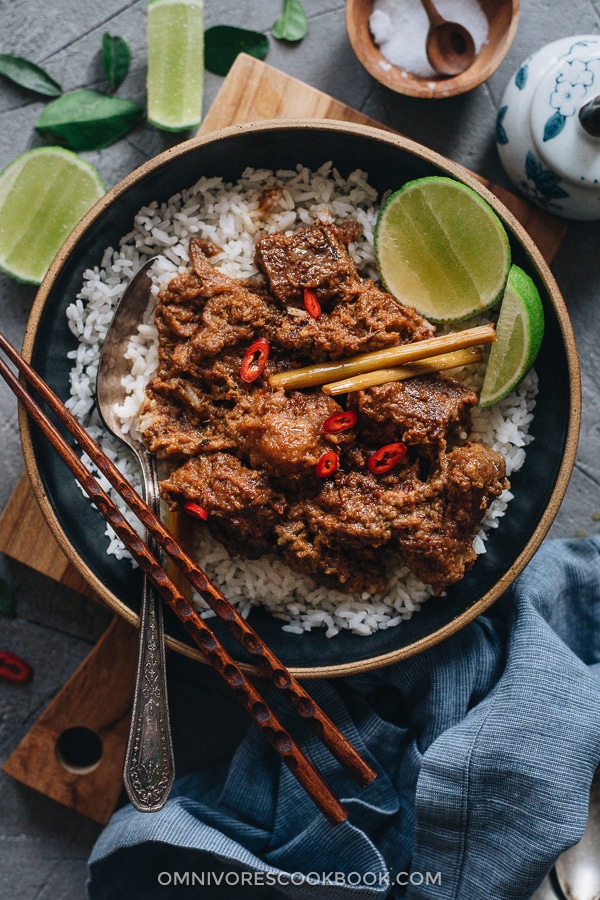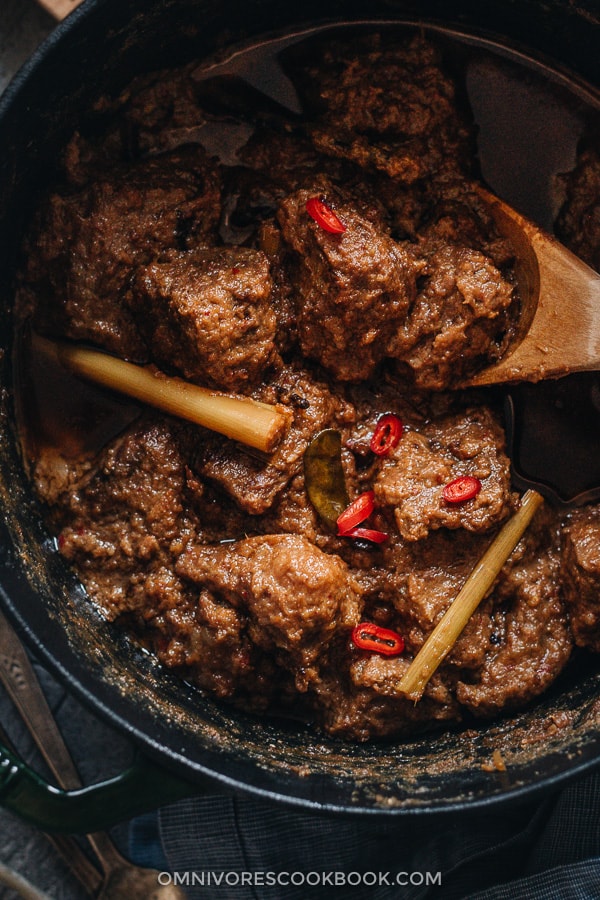The History of Beef Rendang & Recipe

Beef Rendang is a traditional Indonesian dish with a rich history and cultural significance. Here's a brief history of Beef Rendang:
- Origins:
Beef Rendang has its roots in the Minangkabau people of West Sumatra, Indonesia. The Minangkabau are known for their distinct matrilineal culture, and their cuisine reflects a rich blend of local ingredients and spices. Rendang, in general, is a slow-cooked dish that originated from the Minangkabau culture.
- Cultural Significance:
Rendang is often associated with festive occasions and celebrations among the Minangkabau community. It is commonly served during important events such as weddings, religious festivals, and family gatherings. The dish is a symbol of hospitality and communal togetherness.
- Evolution of the Recipe:
The original Rendang recipe likely involved slow-cooking meat in coconut milk and spices to preserve it in a region with a warm climate. This slow-cooking method not only tenderized the meat but also helped in preserving it for longer periods. Over time, the dish has evolved, and regional variations have emerged, each with its unique blend of spices and cooking techniques.
- Rendang Beyond Minangkabau:
The popularity of Beef Rendang has transcended regional boundaries and become a beloved dish not only in Indonesia but also internationally. It gained widespread recognition and appreciation, particularly after being featured in culinary publications and television shows around the world.
- International Recognition:
In 2011, Beef Rendang received international acclaim when it was declared the "World's Most Delicious Food" by CNN Travel in a global poll. This recognition further elevated the dish's status and introduced it to a broader audience.
- Ingredients and Preparation:
Beef Rendang is made with chunks of beef slow-cooked in coconut milk and a rich blend of aromatic spices. The key ingredients include coconut milk, lemongrass, galangal, turmeric, ginger, garlic, shallots, and a variety of chili peppers. The slow-cooking process allows the flavors to meld together, creating a tender and intensely flavorful dish.
Beef Rendang's journey from the traditional kitchens of the Minangkabau people to international acclaim reflects the richness of Indonesian culinary heritage. Its aromatic blend of spices, tender meat, and creamy coconut milk have made it a beloved and iconic dish, celebrated both for its cultural significance and exquisite taste.

Traditional Beef Rendang Recipe ;
Ingredients:
- 2 lbs (about 1 kg) beef, cut into bite-sized chunks
- 2 cans (800ml) coconut milk
- 4 kaffir lime leaves, torn
- 2 stalks lemongrass, bruised
- 4 tablespoons cooking oil
- 1 turmeric leaf (optional), torn
- Salt, to taste
Spice Paste (Rendang Paste):
- 8 shallots, peeled
- 6 cloves garlic, peeled
- 5 red chillies, seeded
- 5 dried chillies, soaked in hot water
- 2 thumb-sized pieces of galangal, peeled
- 2 thumb-sized pieces of ginger, peeled
- 2 stalks lemongrass, white part only
- 1 tablespoon coriander powder
- 1 teaspoon cumin powder
- 1 teaspoon fennel powder
- 1 teaspoon turmeric powder
Instructions:
- Prepare the Spice Paste:
- In a blender or food processor, combine all the ingredients for the spice paste and blend until you get a smooth paste.
- Cooking the Beef:
- Heat the cooking oil in a large, heavy-bottomed pot over medium heat.
- Add the spice paste and sauté until it becomes aromatic and the oil begins to separate.
- Add the Beef:
- Add the beef chunks to the pot and stir well to coat them with the spice paste.
- Coconut Milk and Lemongrass:
- Pour in the coconut milk, add the torn kaffir lime leaves, bruised lemongrass, and torn turmeric leaf (if using).
- Stir well and bring the mixture to a boil.
- Simmering:
- Once it boils, reduce the heat to low and let it simmer uncovered. Stir occasionally to prevent the coconut milk from sticking to the bottom of the pot.
- Slow Cooking:
- Continue to simmer and cook the beef in the coconut milk until the liquid has evaporated, and the mixture becomes thick and dark brown. This slow-cooking process may take around 2 to 3 hours.
- Finishing Touch:
- As the liquid reduces, the coconut milk will turn into coconut oil, coating the beef in a rich, flavorful sauce.
- Adjust the seasoning with salt to taste.
- Serve:
- Once the beef is tender and the sauce has thickened, remove the pot from heat.
- Discard the lemongrass stalks and turmeric leaf.
- Serve the Beef Rendang with steamed rice or your favorite accompaniments.

Enjoy the rich and aromatic flavors of this classic Indonesian dish!
I recommend you to watch Tangbao recipe videos I share;
Malaysian/Indonesian Beef Rendang Recipe;
Classic Beef Rendang Recipe;
Indonesia’s No. 1 Beef Curry Beef Rendang Recipe;
Traditional Beef Rendang Recipe;
References;
- Wright, Stephen (3 April 2018). "Should chicken in rendang curry be crispy? Masterchef U.K. sparks debate". Associated Press. Archived from the original on 5 April 2018. Retrieved 5 April 2018 – via Canoe. The curry (rendang), which originates from West Sumatra in Indonesia, is popular in Malaysia, Indonesia, Singapore, Brunei and southern Thailand.
- Keating, Sarah (11 June 2018). "How an outrage over crispy chicken united South-East Asia". BBC Travel. BBC. Retrieved 11 October 2020. Rendang originated from the Minangkabau people of West Sumatra in Indonesia, who cooked it with water buffalo – an important animal in Minangkabau culture – not chicken or beef for which the dish is probably best known.
- Taylor, Jean Gelman (2003). Indonesia: Peoples and Histories. New Haven and London: Yale University Press. pp. 46. ISBN 0-300-10518-5.
- Gita Amanda (5 July 2020). "Antropolog: Rendang Bukan Cuma Makanan Tapi Identitas Budaya". www.republika.com (in Indonesian). Retrieved 18 October 2020.
- Holzen, Heinz Von (15 September 2014). A New Approach to Indonesian Cooking. Marshall Cavendish International Asia Pte Ltd. ISBN 978-981-4634-95-3.
Thank you for reading please give reaction and comment !
#food #indonesian #yummy #cuisine #delicious #foodinspiration #cooking #chefs #meat























































